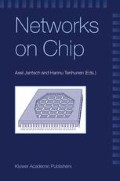Abstract
Due to its heterogeneous and distributed nature, programming NoC communications may be very complicated if we treat NoC as individual elements of resources, switches, and interfaces. To mitigate the complexity, we raise the abstraction level and take NoC as a whole. To this end we propose a concept of NoC Assembler Language (NoC-AL) which serves as an interface between NoC implementations and applications, very similar to the instruction set of a traditional CPU. A central part of NoC-AL will be communication primitives for both message passing and shared memory. Starting with a NoC programmer model, this chapter discusses NoC-AL, and in particular the communication primitives. Moreover, we discuss NoC Operating System (NoC-OS) which is the underlying layer below NoC-AL. As power consumption has become one of the primary design constraints, we give an overview of low power techniques at the operating system level and demonstrate how process migration can improve the effectiveness of the techniques. At the end, we propose an API for power management of NoCs.
Access this chapter
Tax calculation will be finalised at checkout
Purchases are for personal use only
Preview
Unable to display preview. Download preview PDF.
References
L. Benini and G. De Micheli. Dynamic Power Management, Design Techniques and CAD Tools. Kluwer Academic Publishers, 1998.
L. Benini and G. De Micheli. Powering networks on chips. In International Symposium on System Synthesis, Montral, Canada, October 2001.
S. Borkar. Design challenges of technology scaling. IEEE Micro, pages 23–29, 1999.
D. Brooks and M. Martonosi. Dynamic thermal management for high-performance microprocessors. In Int. Symp. on High-Performance Computer Architecture, 2001.
F. Catthoor et al. Code transformations for data transfer and storage exploration preprocessing in multimedia processors. IEEE Design and Test of Computers, pages 70–82, 2001.
L. T. Clark et al. An embedded 32-b microprocessor core for low-power and high-performance applications. IEEE Journal fo Solidstate Circuits, 36(11):1599–1608, 2001.
R. Dick et al. Power analysis of embedded operating systems. In Design Automation Conference, 2001.
D. D. Gajski et al. SpecC: Specification Language and Methodology. Kluwer Academic Publishers, 2000.
T. Grötker et al. System Design with SystemC. Kluwer Academic Publishers, 2002.
A. Jantsch. Networks on chip. In Proceedings of the Conference Radiovetenskap och Kommunikation, 2002.
S. Kumar et al. A network on chip architecture and design methodology. In IEEE Computer Society Annual Symposium on VLSI, 2002.
S-F Li and J. Rabaey. Low power operating system for heterogeneous wireless communication systems. In Workshop on Compilers and Operating Systems for Low Power, 2001.
Y.-H. Lu, L. Benini, and G. De Micheli. Power-aware operating systems for interactive systems. IEEE Transactions on VLSI SYSTEMS, 10(2):119–134, 2002.
L. Luh et al. A high-speed CMOS on-chip temperature sensor. In European Solid-State Circuits Conference, 1999.
D. S. Mikijicic et al. Process migration. ACM Computing Surveys, 32(3):241–299, 2000.
P. Pillai and K. G. Shin. Real-time dynamic voltage scaling for low-power embedded operating systems. In Proceedings of 18th ACM Symposium on Operating Systems Principles, October 2001.
T. Simunic and S. Boyd. Managing power consumption in networks on chips. In Design, Automation and Test in Europe, 2002.
W. R. Stevens. Unix Network Programming, Volume 1-Networking APIs: Sockets and XTI, second edition. Prentice Hall, 1998.
P. Yang et al. Energy-aware runtime scheduling for embedded multiprocessors SOCs. IEEE Design and Test of Computers, pages 46–58, 2001.
T. Yen and W. Wolf. Communication synthesis for distributed embeded systems. In IEEE International Conference on Computer-Aided Design, 1995.
Author information
Authors and Affiliations
Editor information
Editors and Affiliations
Rights and permissions
Copyright information
© 2003 Kluwer Academic Publishers
About this chapter
Cite this chapter
Lu, Z., Haukilahti, R. (2003). NoC Application Programming Interfaces. In: Jantsch, A., Tenhunen, H. (eds) Networks on Chip. Springer, Boston, MA. https://doi.org/10.1007/0-306-48727-6_12
Download citation
DOI: https://doi.org/10.1007/0-306-48727-6_12
Publisher Name: Springer, Boston, MA
Print ISBN: 978-1-4020-7392-2
Online ISBN: 978-0-306-48727-9
eBook Packages: Springer Book Archive

